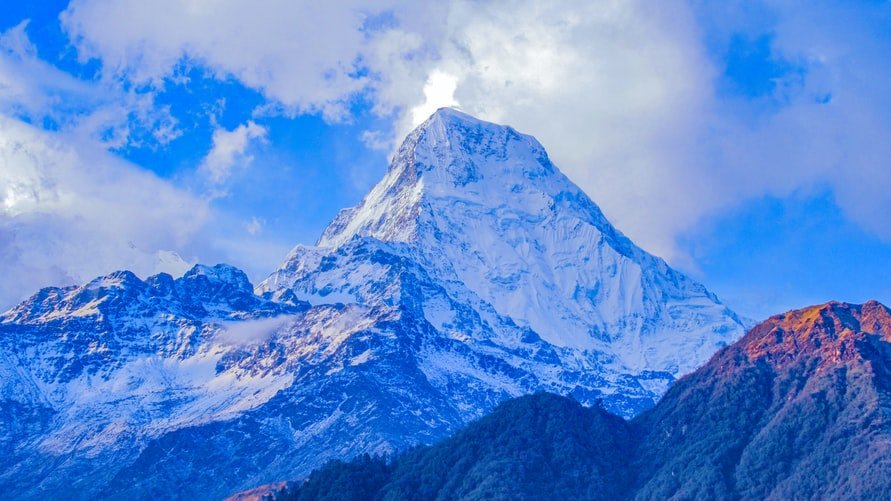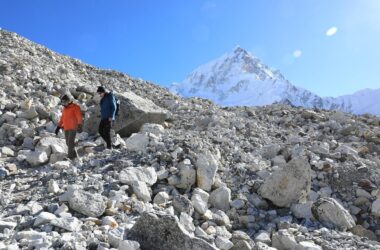Contents
Overview
Annapurna base camp is one wondrous trekking site located amidst the Annapurna Range, Nepal. The trek provides panoramic vistas of the pyramidal mountains, verdant forests, and varied sceneries. The trail starts from Pokhara and passes through beautiful villages, terraced fields, and rhododendron forests. The final place, Annapurna Sanctuary, lies above sea level of 4130 m on which plenty of gigantic peaks appear like Annapurna I (8091 m). Trekkers witness a rich cultural landscape, meeting the Gurung and Magar people in the areas. ABC is famous for its amazing scenery which attracts trekkers to the Annapurna circuit. In this guide, all the details about the Annapurna base camp trek are mentioned below.
How does each day look
Day 1: Reach Pokhara from Kathmandu
- You’ll have to reach Pokharna which is the base camp of this trek, you can find various ways to reach there.
- It will be a 7 hours drive covering a distance of 215 km
- After reaching there you’ll have to book accommodations
- After taking some rest you can go for a walk near the lake
- Return to your hotel for dinner and an overnight stay
Day 2: Drive from Pokhara to Lower Ghandruk
- Today you will drive to Ghandruk from Pokhara
- This is the biggest village you’ll see on this trek
- In this village, you’ll find lots of tea houses and slate and stone-roofed houses
- After a drive of 3-4 hours, you’ll reach Ghandruk
- After reaching there your trek to Komrang will start
Day 3: Komrang to Chhomrong
- Today you’ll trek from Komrang to Chhomrong
- The duration of this trek is 5-6 hours and it is located at an altitude of 260 ft.
- After reaching up there you’ll get to have an amazing view of majestic mountains
Day 4: Chhomrong to Dovan
- The walk from Chhomrong to Dovan is about 6 Km which normally takes around 3-4 hours to finish.
- From Chhomrong the trail descends through stone steps and terraced fields.
- The walk provides a breathtaking panorama of mountains nearby including the views of Annapurna South and Machapuchare
- Dovan lies at a lesser elevation than Chhomrong creating a new perception of the Annapurna area’s natural scenery.
Day 5: The base camp of Machapuchare to Dovan
- A hike from Dovan to Machapuchare Base Camp (MBC) takes up to 5 km and lasts around 3 – 4 hours.
- Machapuchare Base Camp is located approximately 3,700 meters (12,139 feet)
- The track winds from Dovan through both forests hatched with trees and rocky areas.
- The track bears the unprocessed charm of the Himalayas, with the ever-expanding peaks seeming within an arm’s reach.
Day 6: Machapuchare Base to Annapurna base camp
- The hike from Machapuchare Base Camp to Annapurna Base Camp is around 2.5 kilometers and usually, it takes about 2-3 hours to finish.
- The ABC trail from MBC follows an upward, slightly rocky route and moraines
- Annapurna Base Camp lies at an elevation of nearly 4,130 meters
- It’s a pretty place surrounded by tall snow-covered mountains all around
Difficulty level of Annapurna base camp trek
The Annapurna base camp trek is rated as a moderate trek on the scale of difficulty level. This trek will start from Pokhara which is located at an altitude of 2,760 ft. and the maximum altitude you’ll reach is 13,550 ft. in 6 days.
As you reach near the Annapurna base camp the terrain becomes a bit challenging. A trek back from the ABC is a long walk of almost 9 hours. It can be a difficult trek for beginners but it is the best trek for experienced trekkers. Before going on this trek you need to prepare yourself you around 8 weeks and you should aim to cover 10 km in under 60 minutes.
Best time for the trek
The best time for the Annapurna base camp trek is from March to May (spring) and September to November (autumn). During these months, the weather is warmer as compared to autumn, you’ll only find snow at the higher altitudes during the spring season.
The air flowering in spring is moist and in October it is dry and crisp.
Trek to Annapurna base camp in spring
In the springtime, the Annapurna Base Camp becomes a lusty panorama of nature. During March to May, the forests are covered with blooming rhododendrons which makes the trail full of vibrant colors. The weather is nice and stable which makes it a perfect time for hiking. Snow-covered peaks, that is Annapurna and Machapuchare, loom above the clear blue skies, providing splendid views. The pleasant weather, green scenery, and cheerful local villages add much to the trek thus spring is the season of choice for trekkers desiring to strike the perfect balance between the beauty of nature and the comfort of trekking.
Trek to Annapurna base camp in autumn
Fall makes the Annapurna Base Camp trek a fascinating trip of clear sky, cool weather, and breathtaking scenery. The region has steady weather with little precipitation from September to November. The sharp air gives visibility better to see the unobstructed magnificent Annapurna and Amaanda Mountains. The beauty of the vast verdant landscape and terraced fields, punctuated with a kaleidoscope of colorful local festivals makes for an exciting trip. With moderate temperatures by day and starry clear nights, autumn is the preferred time of the year for trekkers seeking the right balance of good weather and spectacular views in the Annapurna region.
How to reach the base camp
By air: Travel to Annapurna Base Camp by flight, fly to Kathmandu, Nepal’s Tribhuvan International Airport. From Kathmandu, take a short domestic flight to Pokhara Airport. You can also either drive or take a bus from Kathmandu to Pokhara as well. The trek to Annapurna Base Camp starts in Pokhara; access Nayapul by road and commence hiking through beautiful villages and varied landscapes.
By train: Since Annapurna Base Camp is in Nepal there is no direct train route. Yet, at least a railway station in India can be reached most closely, the station being Gorakhpur Junction. Travel by road from Gorakhpur to Kathmandu which is the capital of Nepal. Then proceed to Pokhara either by bus or by plane. The trek to Annapurna Base Camp commences from Nayapul which can be reached by a drive from Pokhara.
By road: The easiest way to the Annapurna Base Camp is by driving to Pokhara city which is an important access point to the Annapurna region. From Pokhara, hire a jeep or catch a local bus to Nayapul, the commencement point of the trek. The road trip has dramatic sceneries and it takes approximately 1.5 to 2 hours. Making your way from Nayapul through the beautiful villages and various landscapes you will reach Annapurna Base Camp.
What to pack for the trek
1. Mandatory documents
- You need to carry a government ID card, you can only carry a passport or voter ID card in Nepal for identification
- Carry one passport-size photo of yourself
- Do carry a medical certificate signed by a practicing doctor
2. Essential items
- A backpack which can store all items
- Comfortable hiking shoes
- Warm and comfortable clothes
- Trekking pants
- Sunscreen, moisturizer, and cap
- A pair of socks, a woolen cap, sunglasses
- Trekking pole
- Essential toiletries
3. Medical kit
- First aid supplies
- Prescribed medications
- Bandage
- Medicines like Combiflam, diamox, dolo 650, ORS, and digene
FAQ’S
1. When is the best time for the Annapurna Base Camp trek?
The best time is in spring from March to May and autumn from September to November when the weather is good and the mountains are clear and uncluttered with clouds.
2. Do I need a permit for trekking?
And yes, trekkers require an Annapurna Conservation Area Permit (ACAP) as well as a Trekkers’ Information Management System (TIMS) card.
3. How challenging is the hike to Annapurna Base Camp?
It is regarded as moderate which can be suitable for trekkers with an average level of fitness. There may be altitude-associated challenges hence acclimatization is vital.
4. What could be the short-term accommodations for trekking?
Teahouses and lodges are located along the route offering simple amenities. Advanced booking during peak seasons is recommended.
5. Is there an ATM facility on the trek path?
ATM is not available, hence bring enough cash from Pokhara.
6. Should I hire a guide or i can trek on my own?
Both options are doable, but when trekking for the first time it is better to hire a guide because the route is well-marked and local guides provide cultural insights.




